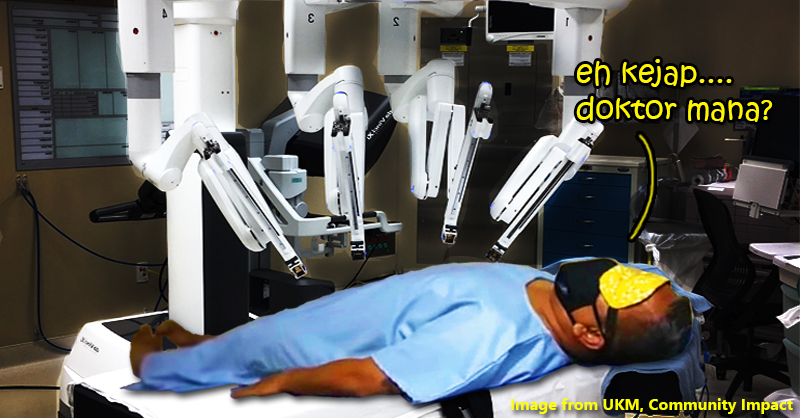Can this Sunway Hospital robot do surgeries better than a human doctor?

- 168Shares
- Facebook144
- Twitter6
- LinkedIn5
- Email5
- WhatsApp8
At some point or another, we’ve probably all wondered the same thing: When will robots take over the world?
It kinda feels like an inevitable question, what with movies like The Terminator playing up the whole man vs. machine apocalypse. Now say you’ve watched The Terminator, you’re a little disturbed, so you head to your fav makan place for some comfort food. Only for a robot to serve the dish 😱

And now with the new AI chatbot going viral, it’s starting to sink in…these bots are everywhere.
In fact, the number one industry they can be found in is healthcare. And you’re probably familiar with some of them, like prosthetics and pacemakers and even hearings aids to a degree. But seriously, as advanced as these devices are, they’re nothing compared to what we saw being demonstrated at Sunway Hospital–a legitimate robot surgeon, the da Vinci Surgical System.

Okay, deep breaths, this isn’t a Terminator takeover and you don’t have to go looking for alternative medicine options just yet. The robot isn’t actually conducting the surgery since…
The doctor is the one controlling the robot
If you’re thinking, what’s so great about this robot and why are we using it in surgeries? Well, the general idea is that robots eliminate the risk of human error, kind of like a medical autocorrect. So when a surgeon has hand tremors, or when they grow tired while performing a super long surgery, they can make mistakes. Which of course doesn’t happen with a robot.

So back at Sunway Hospital, we witnessed firsthand how the da Vinci system worked. Honestly, it was art in motion. The doctor sat at a console, far away from the patient and robot. He twisted his hands and the robot arms mimicked it on a smaller, more precise scale. With just a pair of joysticks and a foot pedal, the doctor could manipulate the robot to even tie the tiniest knot.

Also, trivia of the day, the system is called da Vinci because Leonardo da Vinci, famed painter of the Mona Lisa, is considered by many to have created the first robot.

But can we trust a robot to not go all Terminator on our organs?
Like any other new gizmo that hits the market, there’s awe, there’s fascination, there’s a question of: is this Scissorhand looking robot actually safe to use?
So let’s start off with the good stuff. The doctors are all for the robot, after seeing how well patients were recovering after their operations.
“It’s more precise, less blood loss and faster recovery… Because the responses were good, more doctors came to adopt this (robotic) method,” – Dato’ Lau Beng Long, President of Sunway Healthcare Group in a media conference.
There was also the fact the newest edition of this robot has a fluorescence feature, which can light up certain body structures and is especially handy in gynecology.
“As gynecologists, (we have to) be careful of the ureter because the ureter passes by the uterus and it’s so close and hidden. So when we shine the fluorescence, we will never miss the ureter,” – Dr. Tan Ee Ping, Consultant Obygyn in a media conference
Yaaaaas, we love a glow up🌈
So yes, it ticks a lot of boxes, but it does come with some cons. A large majority of insurance companies in Malaysia don’t cover the cost of robotic surgeries. And this is in addition to the fact that robotic surgeries are way more expensive than the regular conventional method. So you can expect to pay an arm and a leg and mayhaps a couple of organs too.

Then there’s the matter of controlling the machine. Even the most proficient surgeon needs extra training before he or she can operate using the robot.
“In general, the proper way to do it is to go for a fellowship (that) would take 1 – 2 years. At the moment, there’s no recognised training centre within Malaysia,” – Dr. Tan Guan Hee, robotic surgeon and urologist in a media conference
Technicalities aside though, the da Vinci robot does present new opportunities that at one time, seemed impossible.
Now surgeries can be done across countries
It’s kinda mind blowing if you look back at medicine and see how far we’ve progressed. We’ve gone from physically visiting doctors, to telemedicine (i.e. diagnosis over telephone and video chats), to doctors now operating on patients as far as 400km away.

Imagine that! You could be in critical condition, trapped in a submarine all the way on the ocean bed and the fastest you could get to the nearest hospital is hours later. But with this robot onboard, the surgeon could be above the sea or even in another country and still operate on you. It’s not only underwater operations either, they’re even looking to test this in space!
As for the rest of us, robots make emergency medicine a lot more accessible. For people living in remote areas, or for people who can only get the surgery they need in another country, all there needs to be now is a robot in their vicinity. Already there are talks of making this possible.
But would you trust a robot over a human doctor?
Here’s the thing. While it’s super interesting to indulge in all these possibilities and reach for the stars, there’s also that question of what it means to live in such a digitalised world. And also the risks of being so reliant on technology and electronics in life-or-death situations.
Like let’s say, the electricity goes out, what then? Or if the robot’s software is faulty or if hackers break into the system and go all ninja chop chop on us? And in those scenarios, who will be held responsible? The doctors? The hospitals? The companies that supplied the robots?

As it stands, there are some security precautions in place. But as we all know, the more sophisticated our technological advances, equally the more sophisticated the cyber-attacks towards them. On paper so far, the robot sounds pretty damn impressive, but ultimately, it comes down to you. When you’re signing your surgical form and given the option of man vs robot, who would you choose?
- 168Shares
- Facebook144
- Twitter6
- LinkedIn5
- Email5
- WhatsApp8


